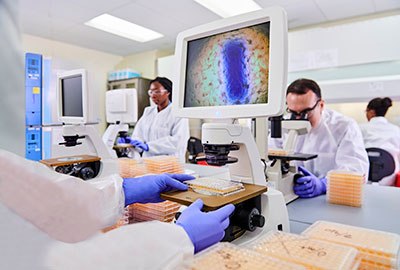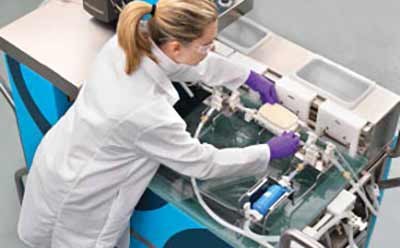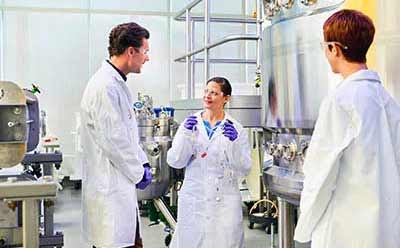Detecting Viral Contamination in mAb Process

In today’s biomanufacturing environment, confirming that process intermediates are free from detectable adventitious virus presents challenges. Traditional in vitro and in vivo virus testing typically take several weeks to complete and frequently offer limited sensitivity and identification of specific contaminants. Additionally, regulatory and ethical imperatives to decrease the use of animal models has reinforced demand for a new approach to biosafety testing. Molecular testing technologies have been developed, offering speed to results with the sensitivity and specificity to meet the needs of today’s biomanufacturers.
The evolution of biomanufacturing towards process intensification and continuous manufacturing, coupled with the more diverse range of patient treatments being developed, are powerful drivers for this new approach to accelerated biosafety testing.
Rapid Detection Methods
Molecular testing technologies for detecting viral contamination can often deliver results in a few days or a week, compared to up to and often beyond 35 days for more traditional bulk harvest lot release testing methods. Directed polymerase chain reaction (PCR) and next generation sequencing (NGS) technologies each have advantages: PCR offers speed and sensitivity, while NGS features a broad detection range. A new rapid molecular detection platform utilizing a highly multiplexed degenerate PCR approach combines the benefits of both traditional PCR and NGS: rapid results with coverage of more than 5,000 viral variants, expediting biomanufacturing timelines for enhanced productivity.
Cell Line Characterization
Regulatory bodies currently require extensive cell line characterization to confirm species origin and history, as well as identity, stability, and purity. Today there are many options for this level of cell line analysis, with newer molecular methodologies offering more rapid time to results, allowing developers to get to clinic faster.
Raw Material Testing
Raw materials are a source of variability in biomanufacturing. Supplier transparency, coupled with comprehensive testing to fully characterize raw materials, as well as easy-to-access documentation, provide assurance that raw materials are fit for purpose.
Detection of Emerging Viruses
Viral contamination is a constant challenge to all biopharmaceutical production processes, with emerging viruses a particular concern. Understanding the susceptibility of raw materials to these viral contaminants, and the capability of both classical and molecular testing methods to detect them, is an essential part of any viral safety strategy.
Visit our document search for data sheets, certificates and technical documentation.
Workflow


Removing Viruses Downstream
Implementation of technologies to remove or inactivate viruses and execute clearance studies that demonstrate process safety.

Monoclonal Antibody Manufacturing
Monoclonal antibody (mAb) therapeutics are manufactured using a templated approach that requires robust, scalable solutions for all steps from cell line development to final fill.
Related Articles
- Viral safety in bioprocessing relies on a framework of (1) preventing contamination, (2) detecting contamination, and (3) removing or inactivating viral contaminants.
- Multivariate data analysis (MVDA) makes possible a proactive, real-time approach to monitoring, controlling, and predicting quality and productivity in biomanufacturing. The use of proven software with guided PCA and PLS model creation means you don’t need to be a data scientist to explore and analyze your data.
- Key aspects of single-use assembly qualification including quality by design (QbD), quality risk management (QRM) and operator handling and training.
- Before adoption of single-use technologies in biomanufacturing, manufacturers must assess the risk to the drug product from potential leachables. This article highlights a general approach based on the United States Pharmacopeia (USP).
- Discover how low-impurity iron sources improve reliability and performance in recombinant protein production with EX-CELL® Advanced medium.
- See All (15)
Related Protocols
- This article describes a purification process resulting in low nanoparticulate impurities sucrose, enabling more stable protein formulations.
- See All (1)
Find More Articles and Protocols
Related Resources
- White Paper: Rapid Biosafety testing enables the future of manufacturing
The safety of biologic medicines relies, in part, on a robust biosafety testing program applied across the biomanufacturing process to evaluate samples for the presence of adventitious agents.
- White Paper: Alternatives to In Vivo Assays for Biosafety Testing of Biologics Medicine Maker Article: A Biosafety Revolution
The use of animal models for the detection of adventitious agents has been a feature of biologic testing packages for many decades. However, as alternative methods such as PCR and NGS have emerged these in vivo tests have stubbornly remained a central part of testing. Here we examine the current in vivo methods and explore alternatives which can be employed today. We also propose that while the industry may be some years away from removing in vivo testing completely, a case can be made for removing animal use from well-characterized production systems such as CHO.
- White Paper: Avoid Surprises With Comprehensive Cell Line Characterization
A robust strategy for viral safety assurance is an essential component of every biopharmaceutical manufacturing process and typically consists of three pillars: prevent, detect, and remove.
- eBook: Viral Safety: a Global Regulatory Perspective
Guidance for Raw Materials and Cell Lines, Preventing Contamination, Detecting Contamination, Viral Clearance Evaluation
How Can We Help
In case of any questions, please submit a customer support request
or talk to our customer service team:
Email custserv@sial.com
or call +1 (800) 244-1173
Additional Support
- Chromatogram Search
Use the Chromatogram Search to identify unknown compounds in your sample.
- Calculators & Apps
Web Toolbox - science research tools and resources for analytical chemistry, life science, chemical synthesis and materials science.
- Customer Support Request
Customer support including help with orders, products, accounts, and website technical issues.
- FAQ
Explore our Frequently Asked Questions for answers to commonly asked questions about our products and services.
To continue reading please sign in or create an account.
Don't Have An Account?
